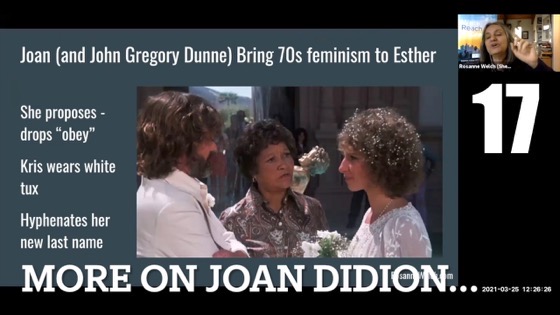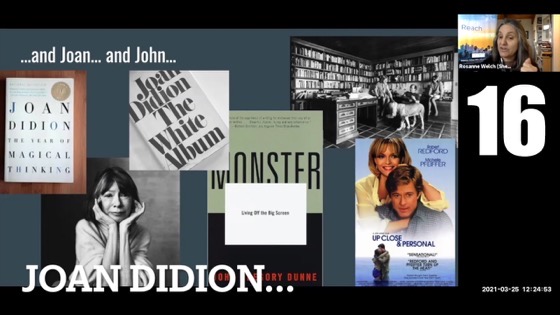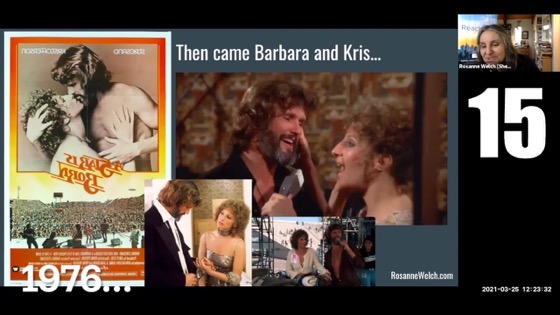Many thanks to Janice Law of the American Women Writers National Museum who invited me to give a short talk on The Women of Early TV.
I enjoyed sharing the names and careers of women like Peg Lynch, Gerturde Berg, Selma Diamond and D.C. Fontana to the members who gathered on Zoom last Wednesday morning. There are so many more I could have talked about whose names don’t appear in mainstream books about the history of television so we have to learn who they are and carry those names forward ourselves. It’s one of the missions of the Stephens College MFA in TV and Screenwriting – and has been one of my missions all my life.

Transcript:
Next, we want to see Selma Diamond. Selma Diamond was an early writer on Your Show of Shows. Look at these names that she is with — Mel Tolkin, Larry Gelbart, Mel Brooks, and Selma Diamond right? She was such a fascinating woman but many people only know her from her part on Night Court which was a show in the late 80s. She stepped into that character. She actually passed away in the course of the show and was replaced by Marsha Warfield. So most people only know her from her acting career but in fact, she was a writer many years earlier. She had some comedy albums that were very very well respected and I happen to know right now her great-nephew is working on a documentary to tell the story of her career because sadly what happens to her and this woman, Lucy Kallen — Lucille Kallen, excuse me. She was also a writer on these early Sid Caesar shows right? So you can see her in this picture. She’s right there doing the work with everybody. She’s part of it everywhere you go except when we start to think about memorializing the people who worked on these shows. Now you have to think about how brilliant Lucille Kallen was. When tv went away from her right when it started to be something that they weren’t really giving her jobs in she began to write murder mysteries. The Tanglewood Murder. That whole CB Greenfield line is her. So she was already in the world of let’s have a continuing series. If I can’t do it on tv, I’ll do it in book form. So this is a woman who wrote all her career and I also happen to love this quote by her — a man’s home is his castle and his wife is the janitor. This is the kind of wit. She’s very much a Dorothy Parker type of person.
Many thanks to Janice Law of the American Women Writers National Museum who invited me to give a short talk on The Women of Early TV.
I enjoyed sharing the names and careers of women like Peg Lynch, Gerturde Berg, Selma Diamond and D.C. Fontana to the members who gathered on Zoom last Wednesday morning. There are so many more I could have talked about whose names don’t appear in mainstream books about the history of television so we have to learn who they are and carry those names forward ourselves. It’s one of the missions of the Stephens College MFA in TV and Screenwriting – and has been one of my missions all my life.
Watch this entire presentation
Women pioneers who created, produced or shepherded many of America’s most wildly popular, early television programs will be profiled by Dr. Rosanne Welch.
Podcast: Play in new window | Download
Subscribe: RSS
![04 Selma Diamond From Women in Early TV for the American Women Writers National Museum [Video]](https://rosannewelch.com/wp-content/uploads/2021/12/rmw-visible-stars-early-tv-04.jpg)


![03 Gertrude Berg From Women in Early TV for the American Women Writers National Museum [Video]](https://rosannewelch.com/wp-content/uploads/2021/12/rmw-visible-stars-early-tv-03.jpg)
![21 The Husband from Concord Days: Margaret Fuller in Italy [Video]](https://rosannewelch.com/wp-content/uploads/2021/12/rmw-concord-day-2021-fuller-rome-21.jpg)

![02 Peg Lynch from “VISIBLE STARS: Women in Early TV” for the American Women Writers National Museum [Video]](https://rosannewelch.com/wp-content/uploads/2021/12/rmw-visible-stars-early-tv-02-1200x675.jpg)



![26 Controversy Scares Broadcasters from Worry and Wonder | The Courier Thirteen Podcast [Video]](https://rosannewelch.com/wp-content/uploads/2021/12/rmw-courier-13-26.jpg)
![52 Conclusion from There And Back Again: Writing and Developing for American TV [Video]](https://rosannewelch.com/wp-content/uploads/2021/12/rmw-oxford-brookes-52.jpg)